The Microstructure and Selected Mechanical Properties of Al2O3 + 13 wt % TiO2 Plasma Sprayed Coatings
Abstract
1. Introduction
2. Materials and Methods
2.1. Materials
2.2. Spray Process
2.3. Microstructural Characterization
2.4. Mechanical Properties
- H—Vickers hardness (MPa);
- E—elastic modulus (MPa);
- 2a—imprint diagonal (m);
- l—average length of cracks (m).
- c = a + l—total length of crack (m);
- P—maximum load of penetrant (N).
- V—volume (mm3);
- S—sliding distance (m);
- N—normal load (N).
3. Results and Discussion
3.1. Coating Microstructure
3.2. Mechanical Properties
4. Conclusions
- Coating microstructure and properties were clearly influenced by the feedstock characteristics. To obtain good coatings, the initial powder properties have to be considered, together with the spraying parameters: the shortest spray distance of 80 mm caused formation of homogeneous coatings with better-melted splats, as the particles impacted the substrate in fully molten state.
- Beside the differences in coatings morphology and microstructure, also observed in the literature, some changes in the phase composition were also noticed. It could also be stated that the ratio of splat area (with γ-Al2O3 and anatase-TiO2) to area with non-melted agglomerates (with α-Al2O3 and rutile-TiO2) can be controlled by plasma spray parameters. The quantities of the phases depend also on the feedstock material.
- The fracture toughness of coatings depends strongly on the spray parameters. Bi-modal microstructure consisting of well-molten and partially melted particles can provide better resistance (more than 20%) against crack formation than well-melted deposits.
- The homogeneous structure of coating and relatively low porosity (below 7% in each case) allowed obtaining satisfactory results of wear resistance in BoD. The highest volumetric wear was observed for coatings sprayed with the longest spray distance of 100 mm, where microcracking, grooving, and detachment of loosely bonded particles were dominant during wear resistance testing. The shorter spray distance results in around 20% better wear resistance than a longer one. It was established that the spray process parameters have an effect on wear resistance of the coatings.
Author Contributions
Funding
Conflicts of Interest
References
- Sahab, A.R.M.; Saad, N.H.; Kasolang, S.; Saedon, J. Impact of Plasma Spray Variables Parameters on Mechanical and Wear Behaviour of Plasma Sprayed Al2O3 3% wt TiO2 Coating in Abrasion and Erosion Application. Procedia Eng. 2012, 41, 1689–1695. [Google Scholar] [CrossRef]
- Vicent, M.; Bannier, E.; Benavente, R.; Salvador, M.D.; Molina, T.; Moreno, R.; Sánchez, E. Influence of the feedstock characteristics on the microstructure and properties of Al2O3–TiO2 plasma-sprayed coatings. Surf. Coat. Technol. 2013, 220, 74–79. [Google Scholar] [CrossRef]
- Geaman, V.; Pop, M.A.; Motoc, D.L.; Radomir, I. Tribological properties of thermal spray coatings. Eur. Sci. J. ESJ 2014, 3, 154–159. [Google Scholar]
- Singh, V.P.; Sil, A.; Jayaganthan, R. Tribological behavior of plasma sprayed Cr2O3–3%TiO2 coatings—ScienceDirect. Wear 2011, 272, 149–158. [Google Scholar] [CrossRef]
- Steeper, T.J.; Varacalle, D.J.; Wilson, G.C.; Riggs, W.L.; Rotolico, A.J.; Nerz, J. A design of experiment study of plasma-sprayed alumina-titania coatings. J. Therm. Spray Technol. 1993, 2, 251–256. [Google Scholar] [CrossRef]
- Toma, F.-L.; Berger, L.-M.; Stahr, C.C.; Naumann, T.; Langner, S. Microstructures and Functional Properties of Suspension-Sprayed Al2O3 and TiO2 Coatings: An Overview. J. Therm. Spray Technol. 2010, 19, 262–274. [Google Scholar] [CrossRef]
- Szala, M.; Walczak, M.; Pasierbiewicz, K.; Kamiński, M. Cavitation Erosion and Sliding Wear Mechanisms of AlTiN and TiAlN Films Deposited on Stainless Steel Substrate. Coatings 2019, 9, 340. [Google Scholar] [CrossRef]
- Matikainen, V.; Niemi, K.; Koivuluoto, H.; Vuoristo, P. Abrasion, Erosion and Cavitation Erosion Wear Properties of Thermally Sprayed Alumina Based Coatings. Coatings 2014, 4, 18–36. [Google Scholar] [CrossRef]
- Stengl, V.; Ageorges, H.; Ctibor, P.; Murafa, N. Atmospheric plasma sprayed (APS) coatings of Al2O3–TiO2 system for photocatalytic application. Photochem. Photobiol. Sci. 2009, 8, 733–738. [Google Scholar] [CrossRef]
- Tomaszek, R.; Pawlowski, L.; Zdanowski, J.; Grimblot, J.; Laureyns, J. Microstructural transformations of TiO2, Al2O3+13TiO2 and Al2O3+40TiO2 at plasma spraying and laser engraving. Surf. Coat. Technol. 2004, 185, 137–149. [Google Scholar] [CrossRef]
- Żórawski, W.; Góral, A.; Bokuvka, O.; Lityńska-Dobrzyńska, L.; Berent, K. Microstructure and tribological properties of nanostructured and conventional plasma sprayed alumina–titania coatings. Surf. Coat. Technol. 2015, 268, 190–197. [Google Scholar] [CrossRef]
- Ibrahim, A.; Hamdy, A.S. Microstructure, Corrosion, and Fatigue Properties of Alumina-Titania Nanostructured Coatings. J. Surf. Eng. Mater. Adv. Technol. 2011, 1, 101. [Google Scholar] [CrossRef]
- Ghazali, M.J.; Forghani, S.M.; Hassanuddin, N.; Muchtar, A.; Daud, A.R. Comparative wear study of plasma sprayed TiO2 and Al2O3–TiO2 on mild steels—ScienceDirect. Tribol. Int. 2016, 93, 681–686. [Google Scholar] [CrossRef]
- Richter, A.; Berger, L.-M.; Conze, S.; Sohn, Y.J.; Vassen, R. Emergence and impact of Al2TiO5 in Al2O3-TiO2 APS coatings. Mater. Sci. Eng. 2019, 480, 012007. [Google Scholar] [CrossRef]
- Goberman, D.; Sohn, Y.H.; Shaw, L.; Jordan, E.; Gell, M. Microstructure development of Al2O3–13 wt % TiO2 plasma sprayed coatings derived from nanocrystalline powders. Acta Mater. 2002, 50, 1141–1152. [Google Scholar] [CrossRef]
- Góral, A.; Żórawski, W.; Lityńska-Dobrzyńska, L. Study of the microstructure of plasma sprayed coatings obtained from Al2O3–13TiO2 nanostructured and conventional powders. Mater. Charact. 2014, 96, 234–240. [Google Scholar] [CrossRef]
- Jordan, E.H.; Gell, M.; Sohn, Y.H.; Goberman, D.; Shaw, L.; Jiang, S.; Wang, M.; Xiao, T.D.; Wang, Y.; Strutt, P. Fabrication and evaluation of plasma sprayed nanostructured alumina–titania coatings with superior properties. Mater. Sci. Eng. A 2001, 301, 80–89. [Google Scholar] [CrossRef]
- Luo, H.; Goberman, D.; Shaw, L.; Gell, M. Indentation fracture behavior of plasma-sprayed nanostructured Al2O3–13 wt.%TiO2 coatings. Mater. Sci. Eng. A 2003, 346, 237–245. [Google Scholar] [CrossRef]
- Pawłowski, L. The Science and Engineering of Thermal Spray Coatings, 2nd ed.; Wiley: Chichester, UK, 2008; ISBN 978-0-471-49049-4. [Google Scholar]
- Fauchais, P.L.; Heberlein, J.V.R.; Boulos, M. Thermal Spray Fundamentals: From Powder to Part; Springer: New York, NY, USA, 2014; ISBN 978-0-387-28319-7. [Google Scholar]
- Wahab, J.A.; Ghazali, M.J.; Baharin, A.F.S. Microstructure and mechanical properties of plasma sprayed Al2O3—13%TiO2 Ceramic Coating. MATEC Web Conf. 2017, 87, 02027. [Google Scholar] [CrossRef]
- Pawlowski, L. Suspension and solution thermal spray coatings. Surf. Coat. Technol. 2009, 203, 2807–2829. [Google Scholar] [CrossRef]
- ASTM E2109-01 01 Standard Test Methods for Determining Area Percentage Porosity in Thermal Sprayed Coatings; ASTM: West Conshohocken, PA, USA, 2014.
- EN ISO 4516: 2004 Metallic and other Inorganic Coatings—Vickers and Knoop Microhardness Tests; Swiss Association for Standardization: Winterthur, Switzerland, 2004.
- Palmqvist, S. Occurrence of crack formation during Vickers indentation as a measure of the toughness of hard materials. Arch. Eisenhuettenwes 1962, 33, 629–634. [Google Scholar]
- Niihara, K. A fracture mechanics analysis of indentation-induced Palmqvist crack in ceramics. J. Mater. Sci. Lett. 1983, 2, 221–223. [Google Scholar] [CrossRef]
- Chantikul, P.; Anstis, G.R.; Lawn, B.R.; Marshall, D.B. A Critical Evaluation of Indentation Techniques for Measuring Fracture Toughness: II, Strength Method. J. Am. Ceram. Soc. 1981, 64, 539–543. [Google Scholar] [CrossRef]
- Pędzich, Z.; Piekarczyk, J.; Stobierski, L.; Szutkowska, M.; Walat, E. Twadość Vickersa i odporność na pękanie wybranych kompozytów ceramicznych. Kompozyty 2003, 3, 296–300. [Google Scholar]
- Michalak, M.; Łatka, L.; Sokołowski, P. Comparison of mechanical properties of the plasma sprayed coatings by powder and suspension. Weld. Technol. Rev. 2017, 89, 56–60. [Google Scholar]
- ASTM G99-17 Standard Test Method for Wear Testing with a Pin-on-Disk Apparatus; ASTM: West Conshohocken, PA, USA, 2016.
- Vargas, F.; Ageorges, H.; Fournier, P.; Fauchais, P.; Lopez, M.E. Mechanical and tribological performance of Al2O3-TiO2 coatings elaborated by flame and plasma spraying - ScienceDirect. Surf. Coat. Technol. 2010, 205, 1132–1136. [Google Scholar] [CrossRef]
- Yılmaz, Ş. An evaluation of plasma-sprayed coatings based on Al2O3 and Al2O3–13wt.% TiO2 with bond coat on pure titanium substrate. Ceram. Int. 2009, 35, 2017–2022. [Google Scholar] [CrossRef]
- Yao, S.H.; Su, Y.L.; Shu, H.Y.; Lee, C.I.; You, Z.L. Comparative Study on Nano-Structural and Traditional Al2O3-13TiO2 Air Plasma Sprayed Coatings and their Thermal Shock Performance. Key Eng. Mater. 2017, 739, 103–107. [Google Scholar] [CrossRef]
- Czanderna, A.W.; Rao, C.N.R.; Honig, J.M. The anatase-rutile transition. Part 1—Kinetics of the transformation of pure anatase. Trans. Faraday Soc. 1958, 54, 1069–1073. [Google Scholar] [CrossRef]
- Dachille, F.; Simons, P.Y.; Roy, R. Pressure-temperature studies of anatase, brookite, rutile and TiO2-II. Am. Mineral. 1968, 53, 1929–1939. [Google Scholar]
- Shaw, L.L.; Goberman, D.; Ren, R.; Gell, M.; Jiang, S.; Wang, Y.; Xiao, T.D.; Strutt, P.R. The dependency of microstructure and properties of nanostructured coatings on plasma spray conditions. Surf. Coat. Technol. 2000, 130, 1–8. [Google Scholar] [CrossRef]
- Berger, L.-M.; Toma, F.-L.; Scheitz, S.; Trache, R.; Börner, T. Thermisch gespritzte Schichten im System Al2O3–Cr2O3–TiO2—Ein Update. Mater. Werkst. 2014, 45, 465–475. [Google Scholar] [CrossRef]
- Freudenberg, F. Etude de la réaction à l’état solide Al2O3 + TiO2 → Al2TiO5: Observation des structures: ThéseVÉ cole polytechnique fe´de´rale de Lausanne EPFL. EPFL Lausanne 1988, 709. [Google Scholar]
- Berger, L.-M. Tribology of thermally sprayed coatings in the Al2O3-Cr2O3-TiO2 system. In Thermal Sprayed Coatings and Their Tribological Performances; Engineering Science Reference; IGI Global: Hershey, PA, USA, 2015; pp. 227–267. ISBN 978-1-4666-7489-9. [Google Scholar]
- Łatka, L.; Niemiec, A.; Michalak, M.; Sokołowski, P. Tribological properties of Al2O3+ TiO2 coatings manufactured by plasma spraying. Tribology 2019, 1, 19–24. [Google Scholar] [CrossRef]
- Dejang, N.; Watcharapasorn, A.; Wirojupatump, S.; Niranatlumpong, P.; Jiansirisomboon, S. Fabrication and properties of plasma-sprayed Al2O3/TiO2 composite coatings: A role of nano-sized TiO2 addition. Surf. Coat. Technol. 2010, 204, 1651–1657. [Google Scholar] [CrossRef]

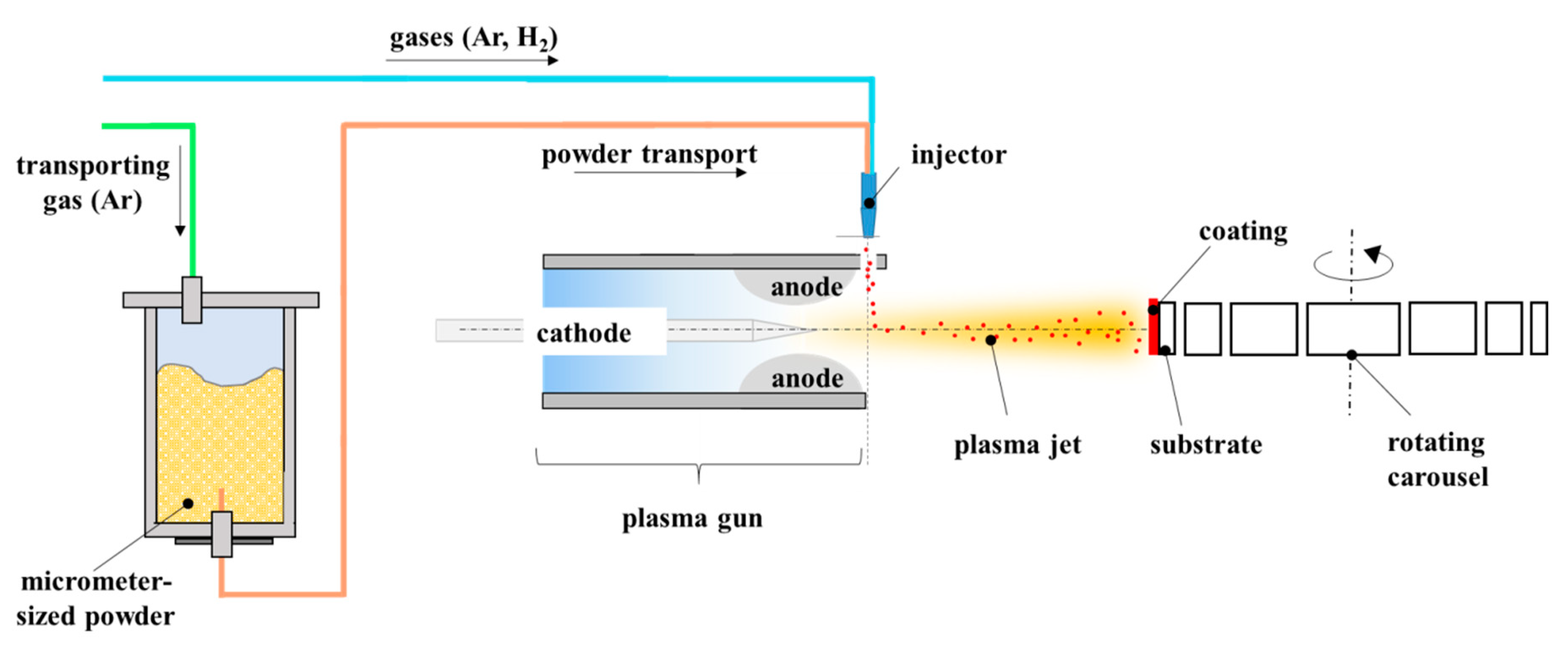



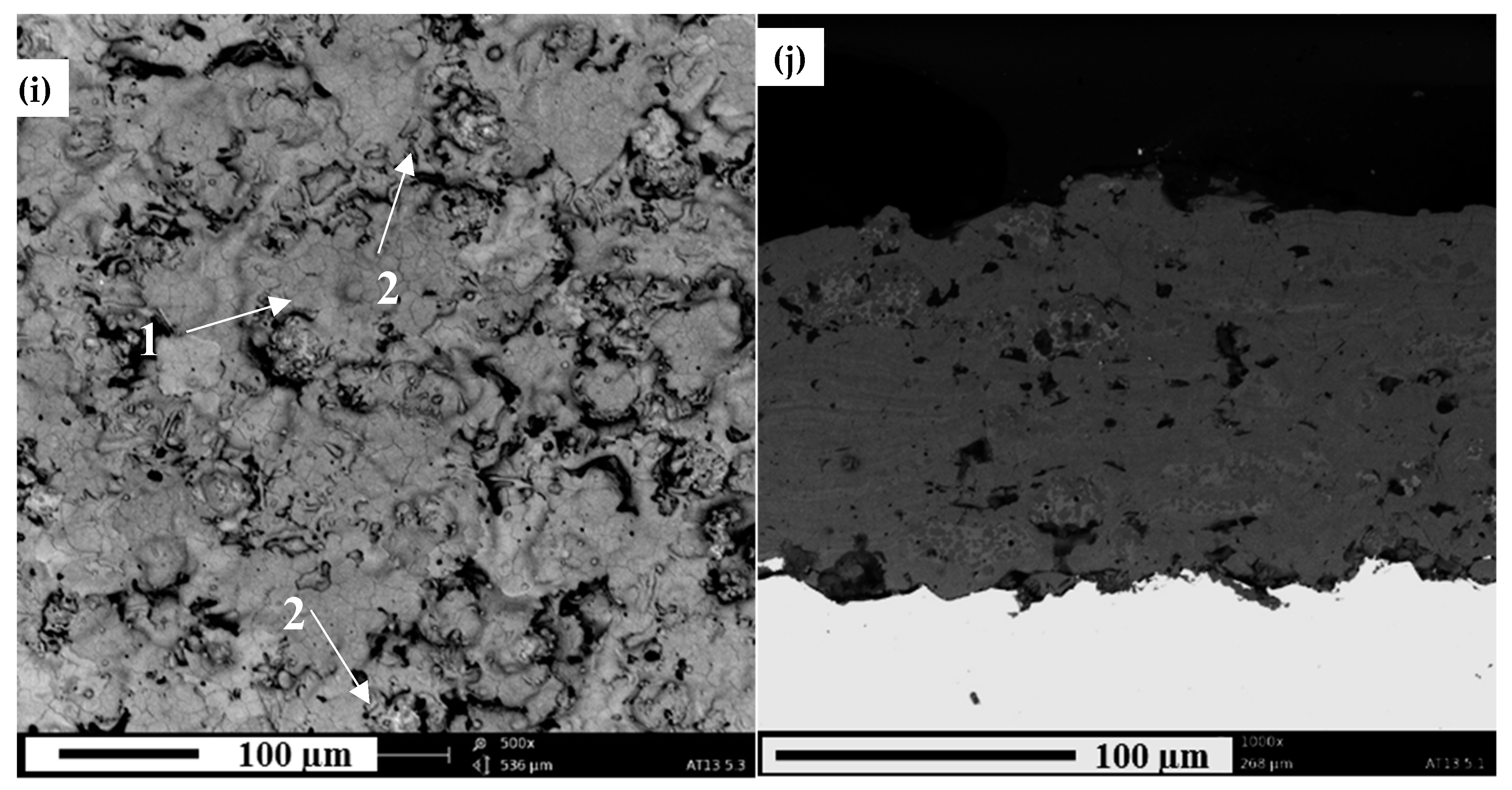
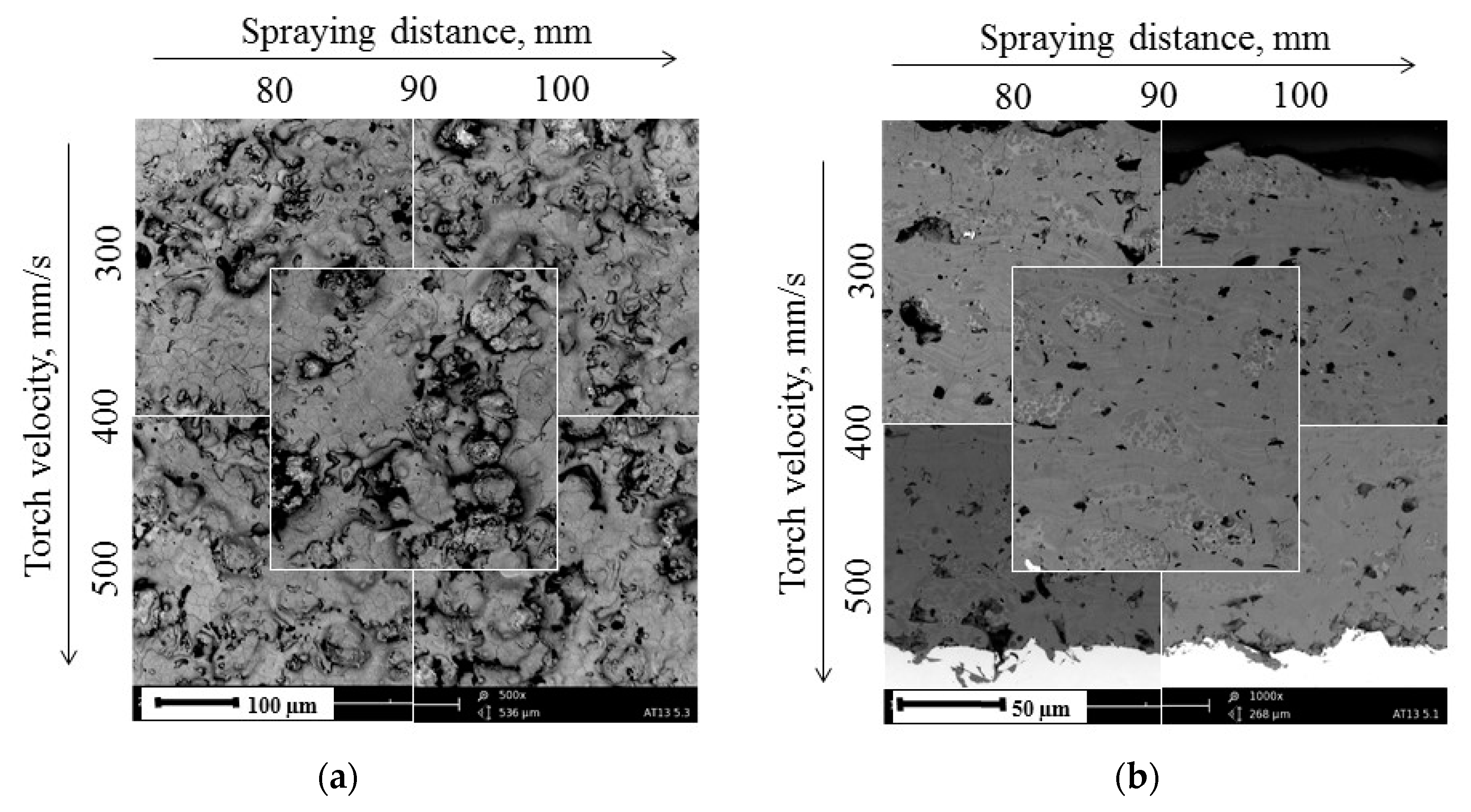
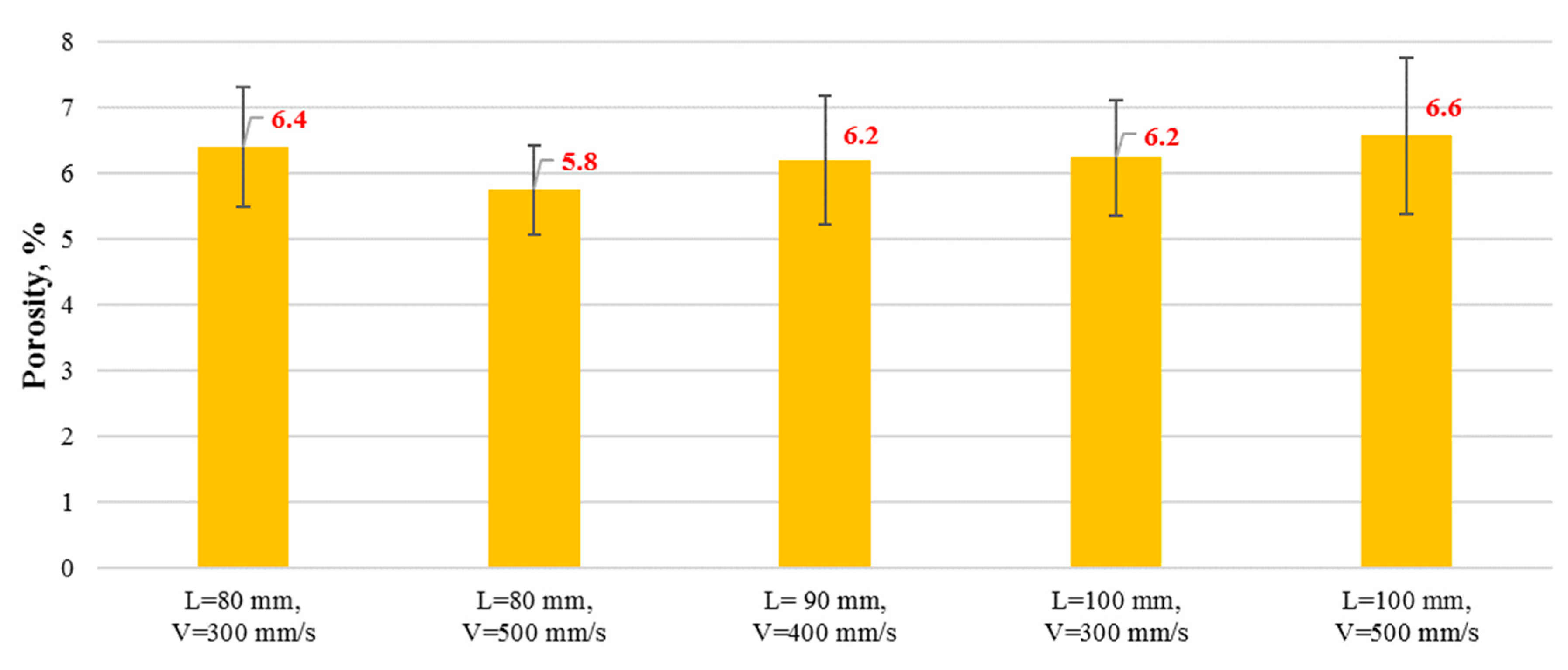

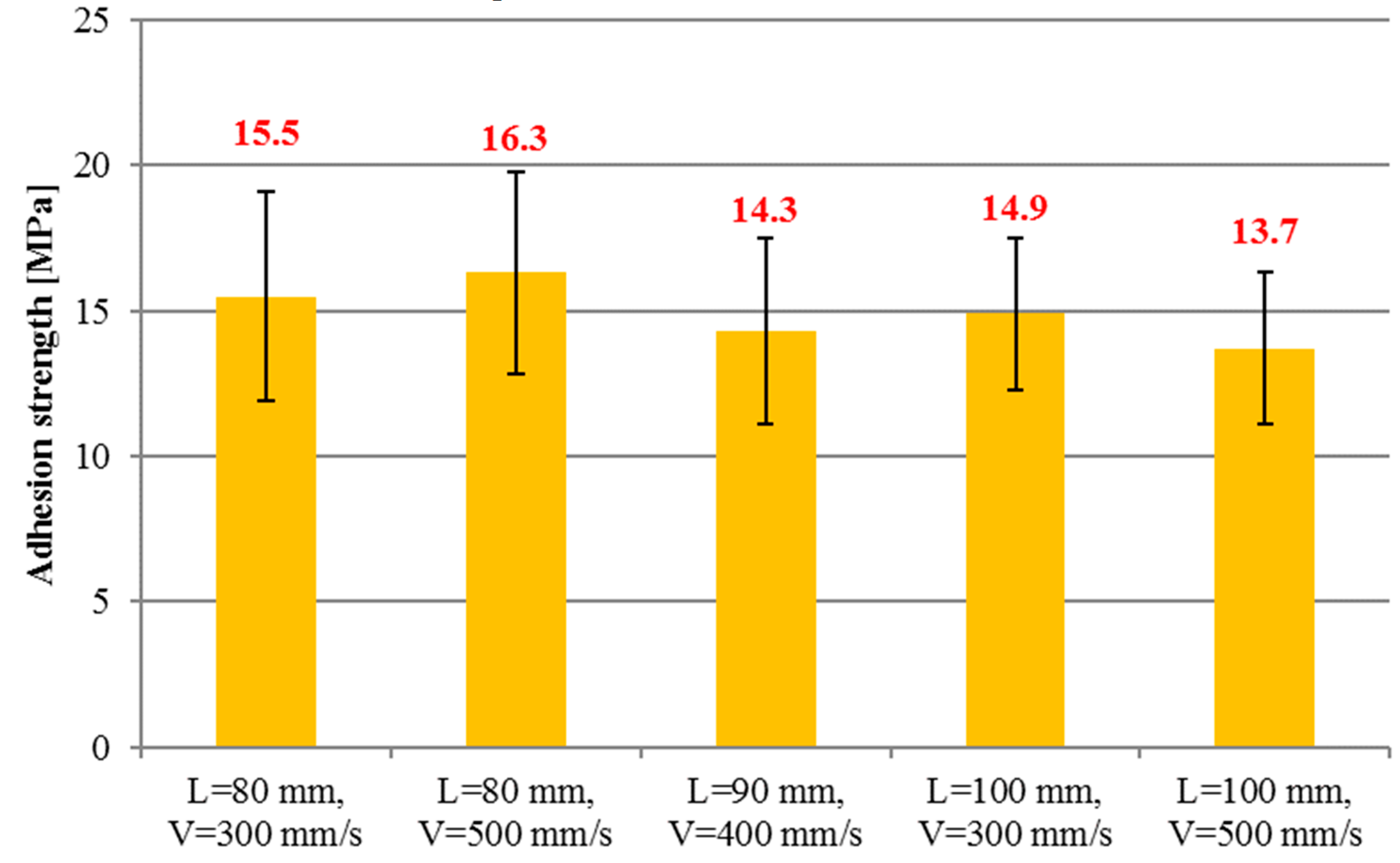
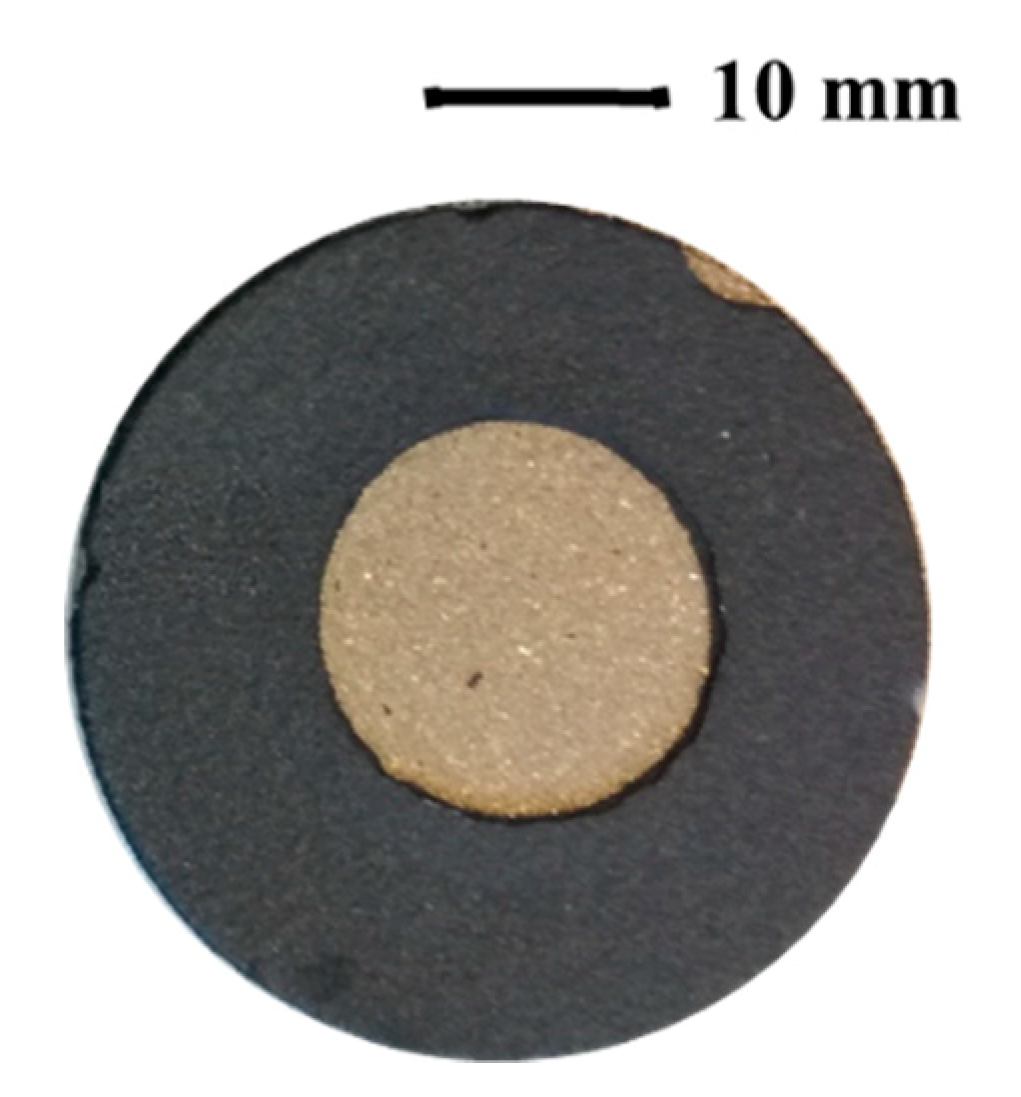
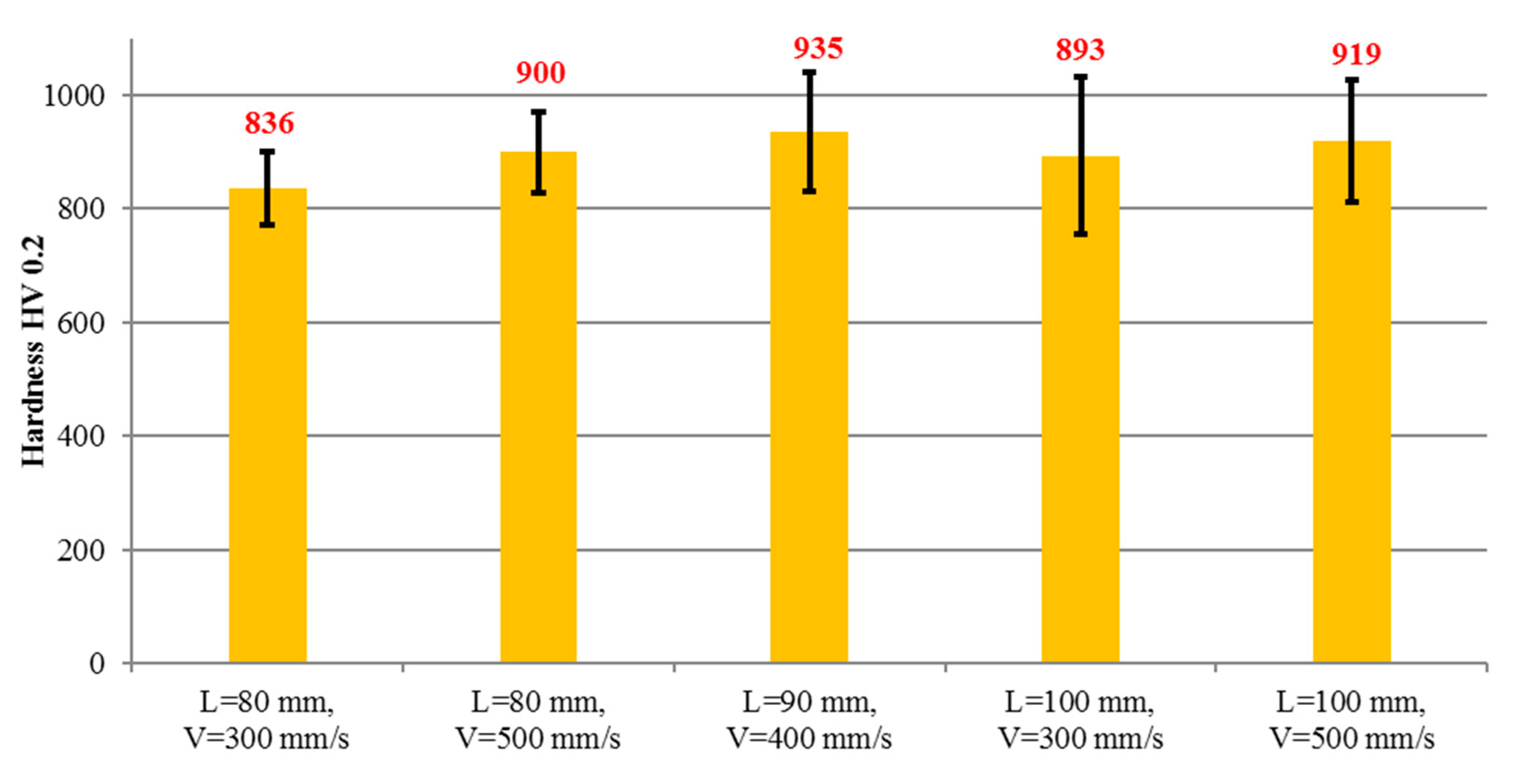
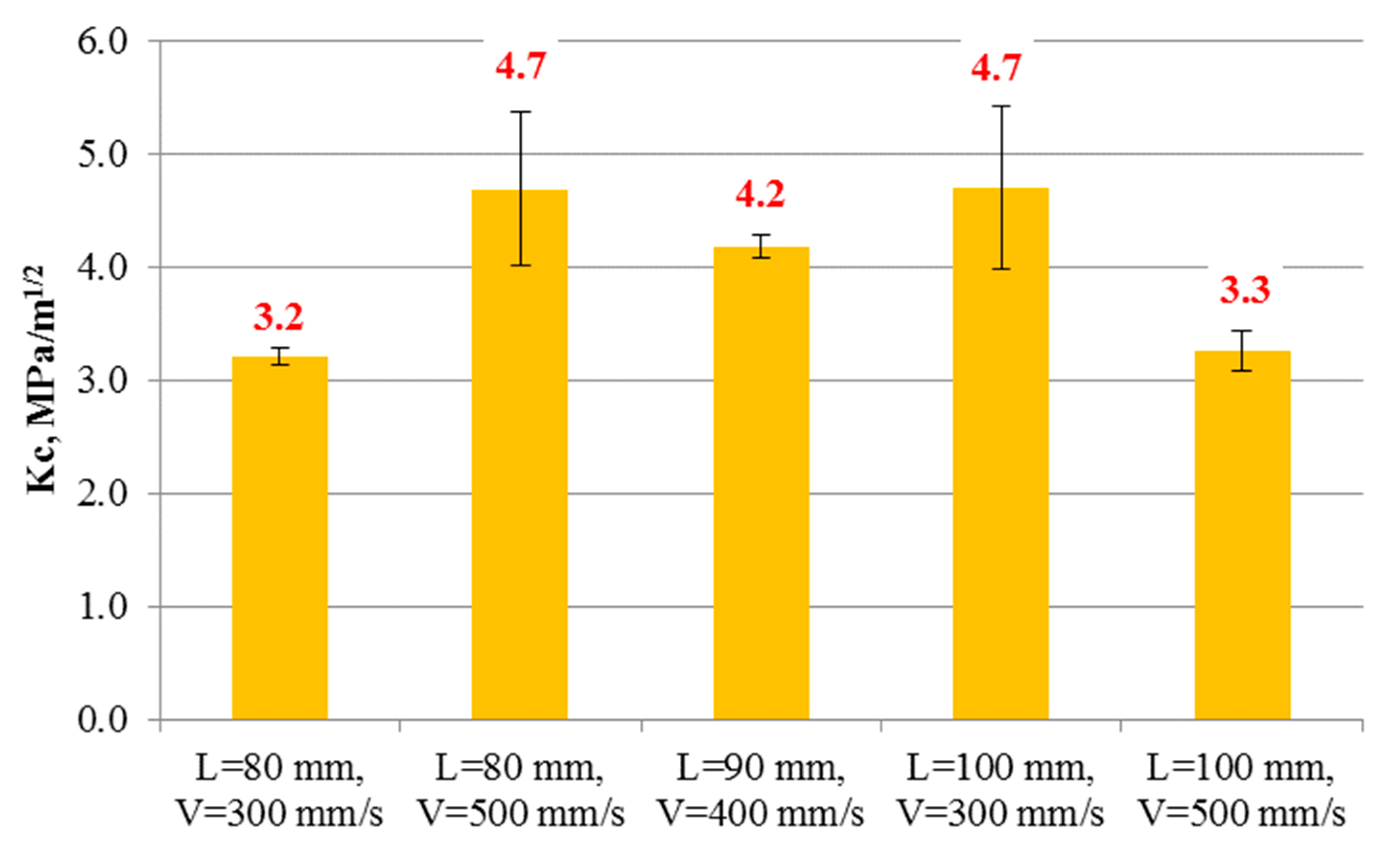
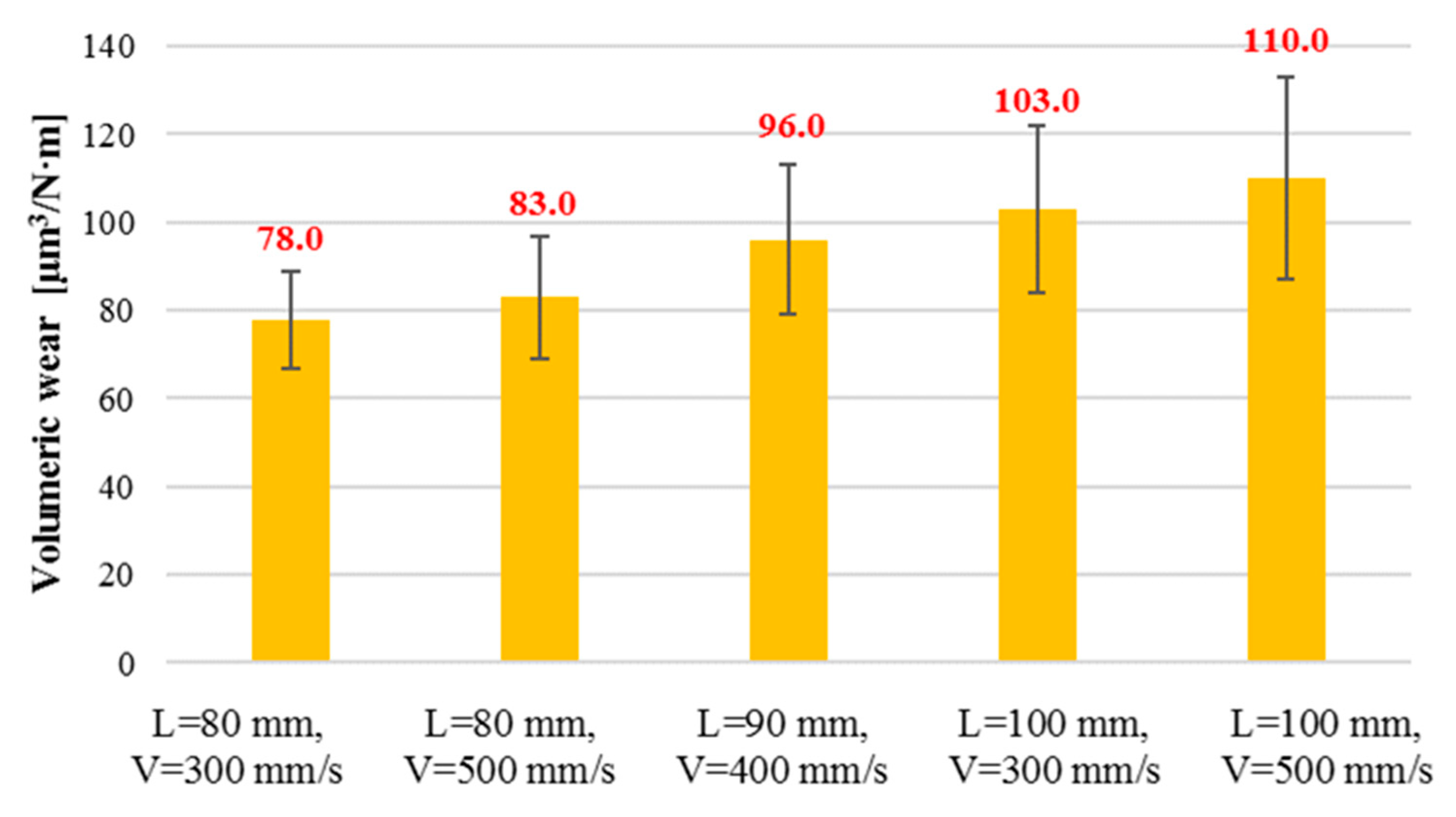

| Sample Code | Spray Distance L, mm | Torch Velocity V, mm/s | Electric Power, kW |
|---|---|---|---|
| AT13-1 | 80 | 300 | 35 |
| AT13-2 | 80 | 500 | |
| AT13-3 | 90 | 400 | |
| AT13-4 | 100 | 300 | |
| AT13-5 | 100 | 500 |
| Ra, µm | Rz, µm | Rt, µm | |
|---|---|---|---|
| AT13-1 | 7.6 ± 0.06 | 50.1 ± 1.24 | 61.9 ± 4.20 |
| AT13-2 | 7.8 ± 0.01 | 51.3 ± 2.21 | 62.3 ± 4.49 |
| AT13-3 | 7.8 ± 0.04 | 50.5 ± 1.02 | 61.6 ± 3.54 |
| AT13-4 | 7.9 ± 0.04 | 50.2 ± 0.92 | 61.9 ± 2.39 |
| AT13-5 | 8.0 ± 0.04 | 52.7 ± 0.95 | 62.7 ± 0.29 |
| substrate | 3.0 ± 0.01 | 22.4 ± 0.14 | 25.8 ± 1.54 |
© 2020 by the authors. Licensee MDPI, Basel, Switzerland. This article is an open access article distributed under the terms and conditions of the Creative Commons Attribution (CC BY) license (http://creativecommons.org/licenses/by/4.0/).
Share and Cite
Michalak, M.; Łatka, L.; Sokołowski, P.; Niemiec, A.; Ambroziak, A. The Microstructure and Selected Mechanical Properties of Al2O3 + 13 wt % TiO2 Plasma Sprayed Coatings. Coatings 2020, 10, 173. https://doi.org/10.3390/coatings10020173
Michalak M, Łatka L, Sokołowski P, Niemiec A, Ambroziak A. The Microstructure and Selected Mechanical Properties of Al2O3 + 13 wt % TiO2 Plasma Sprayed Coatings. Coatings. 2020; 10(2):173. https://doi.org/10.3390/coatings10020173
Chicago/Turabian StyleMichalak, Monika, Leszek Łatka, Paweł Sokołowski, Aneta Niemiec, and Andrzej Ambroziak. 2020. "The Microstructure and Selected Mechanical Properties of Al2O3 + 13 wt % TiO2 Plasma Sprayed Coatings" Coatings 10, no. 2: 173. https://doi.org/10.3390/coatings10020173
APA StyleMichalak, M., Łatka, L., Sokołowski, P., Niemiec, A., & Ambroziak, A. (2020). The Microstructure and Selected Mechanical Properties of Al2O3 + 13 wt % TiO2 Plasma Sprayed Coatings. Coatings, 10(2), 173. https://doi.org/10.3390/coatings10020173







